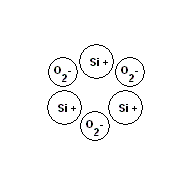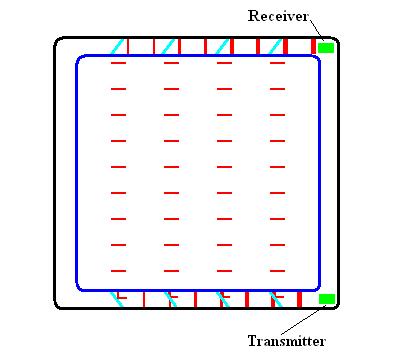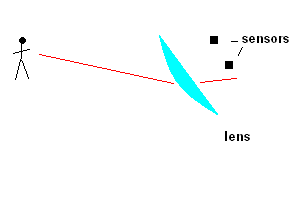
Key Terms
oscillator
piezoelectric crystals
Piezoelectric Effect
Pyroelectric Effect
Certain crystals and ceramics, when stressed, produce a voltage (potential difference) across their surfaces. That is, when you exert a force on a piezoelectric crystal, the ends of the crystal become electrically charged. The word "piezo" (pē-ĀY-zō) means pressure in Greek. This property was first observed by Pierre and Jacques Curie in 1880, but had little practical application because the voltage produced was rather low. Since the 1950's improvements in materials and instrumentation have made piezoelectric crystals a cornerstone in industry as a stress/pressure sensor.

A piezoelectric crystal in action (animation)
It is easy to see why external forces initiate charge separations by examining the animation below. The external stresses literally redistribute the arrangement of atoms so that one side acquires a net positive charge while opposite side acquires a net negative charge.

Applied forces produce charge separation (animation)
Accelerometers are devices that detect changes in motion (like a
gyroscope). One is in your smart phone so it knows its orientation in 3D
space (for compass apps and sky maps, for example). Tiny piezo-crystals
are commonly used to sense when things move and which direction the motion is
taking place. The same thing is found in Wii® gaming systems so you can
out box the champ. A piezoelectric crystal is used to sense when a RF
model airplane is changing direction. The next earthquake will likely be
detected by a piezoelectric crystal mounted in an accelerometer. Note:
Another way of doing the same thing is by using a system of capacitors whose
plate separation changes when subject to accelerations. However,
piezoelectric crystals are still at the heart of most accelerometers.
A digital tire gauge uses a
piezoelectric crystal to measure tire pressure. As the tire pressure
increases, it exerts a greater force on the crystal which produces a higher
voltage. A microcontroller handles the rest. The same idea is used
in digital scales.
Piezoelectric crystals make excellent tactile sensors (devices that need to know
if physical contact is established). Since force initiates a voltage
across the crystal, any force can be converted into an electrical signal which a
microcontroller can use to make something happen. This is especially
useful in the area of robotics. How does a robotic arm "know" when it has
something in its hand? Simple ... use a piezoelectric tactile sensor.
Your car can tell when it is "knocking" by using a piezoelectric sensor.
The vibrations push on the crystal which sends an electric signal to the
computer.
The spark on some cigarette lighters is made by piezoelectric crystals.
When you pull a lever, it stresses the crystal. The result is a high
voltage spark ... similar to the spark you get in a spark plug. The same
idea is used in the push-button igniter of a gas BBQ
grill or fireplace.
These crystals are also
used in microphones. A piezo crystal is connected to a diaphragm inside the microphone housing.
When spoken into, the diaphragm vibrates which also vibrates the
crystal. This creates a voltage that could be amplified.
Are you old enough to remember the days when music was played on vinyl discs? Phonograph needles sometimes used piezoelectric crystals. The idea was to convert grooves on the disk to an electronic signal.
Just as you have seen so many times in the course, a piezoelectric crystal can run in reverse. Look again at this animation:

Is the crystal changing shape because a voltage is applied ... or is a voltage
difference set up because the crystal is changing shape? The answer is ...
you can't tell because both can happen. This opens the floodgates
for a whole new way to use these crystals. The idea is simple: Apply
a charge to the crystal and it changes its shape.
Piezoelectric crystals can be used as fuel injectors (in cars) to push the fuel
into the cylinders
Epson printers utilize piezoelectric crystals to propel ink out of the ink
reservoir and onto your paper.
Ultrasound machines use piezoelectric crystals to generate the high frequency
sound which penetrates the skin. Dentists use the same idea to loosen
plaque off your teeth. Don't forget, fish finders and sonar all use the
same idea. Note: The same crystals can be used to detect the echo signal
since the incoming wave is converted back to electricity when it strikes the
crystal.
Piezoelectric motors are small, but can produce a
lot of torque in relation to their size. The vibrating crystals can be made to
push a surface in one direction so certain arrangements of crystals can lead to
linear or circular motion. Because they can stop within 1 degree of
rotation they become useful in computer disk drives,
Piezoelectric beepers and buzzers are common in digital watches and anything
electronic that goes "beep". They can even be made to play a song in a
greeting card. You can play high quality music driven by piezoelectric tweeters in stereo speakers.

Acoustic wave touch screen (animation)
When a person touches the screen, it blocks some of the waves which would normally reach the receiver. The system is engineered so that the microcontroller will know exactly which wave path was disturbed by measuring the degree to which the signal is reduced. A similar grid is required in the horizontal direction to get an exact coordinate fix. The same technology can be done with infrared radiation instead of ultrasound.
Since these crystals are completely reversible in the way they interchange mechanical vibrations and electric pulses, they have become useful as oscillators. If you have ever played on a swing you know what an oscillator is. On the swing you are constantly converting gravitational potential energy to/from kinetic energy, but in a very rhythmic way. You learn at a very early age at what point of the swing path a push is required to keep the swing moving with this natural motion. Another type of oscillator is found when a weight is suspended by a spring. Intuitively you know when to apply slight pushes to keep the system bouncing up and down (or side to side). The common link here is a system where energy can bounce from one form to another. In these cases, there is a natural oscillation pattern that the system resonates in. You can keep the system "swinging" by adding energy at just the right time and place.
Let's start with a piezoelectric crystal which is vibrating. If you have ever played with a tuning fork you learn that once it is set in motion, it continues to do so in a natural pattern. I'm referring to the natural resonance frequency. Guitar strings, rocking chairs, bungee cords, even swaying buildings all have this natural tendency to move in distinct patterns. The vibrating piezoelectric crystal is no different.
What is special here, however, is that along with the natural pattern of
vibration in the crystal comes a pattern of voltages as well. The key is
to find a way to make this crystal continue to oscillate. Here is one way
you can do that: Tap the electrical energy produced by the crystal and
amplify it. Next feed it back to the crystal (just the right amount and at
the right time ... think about the swing example). This makes the crystal want to
vibrate some more ... which makes more electricity ... which is amplified and
fed back to the crystal ... which (I think you get the idea) ... an
oscillator is born. These become perfect metronomes to beat out the
passage of time and are the heart of all crystal watches.
Earlier computers also used the beating of a piezoelectric crystal to define the
clock speed of the CPU. However, there are even more ways a piezoelectric
oscillator can become useful:
Piezoelectric chemical detectors. Basically, you coat a piezoelectric
crystal with a chemical agent (A) which will react with some different chemical
(B) you wish to detect. The crystal is set into natural vibration and it
vibrates at a known frequency. However, if this crystal comes in contact
with the chemical (B) it is designed to detect, that chemical will react with
the coating (A) and add (or subtract) mass to the crystal itself. This
change in mass results in a change in the resonance frequency of the crystal
(just like tuning forks of different masses will produce different sounds) ...
which a microcontroller picks up and signals an alarm.
The resonate frequency in some piezoelectric materials are temperature
dependent. That is, the rate that they naturally vibrate depends on the
temperature. This can be a problem in most other applications (you don't
want your quartz watch to run at different speeds ... do you?), but not if you
want to make a thermometer out of these materials.
A microcontroller converts these slight shifts in frequency directly into digital temperature readouts.
Piezo-driven fans are useful for cooling CPUs and microcontrollers (which generate unwanted heat). The idea is to attach thin plates to the surface of an oscillating crystal which act to circulate air (and heat) away from the source. Since they are reliable and quiet they can be found in cell phones and computers.
Another interesting property exhibited by certain polarized crystals (like zinc oxide) is the Pyroelectric Effect. Crystals with this property produce electric charges on their surfaces when heated. That is, when the crystal undergoes a temperature change, it acts very much like a piezoelectric crystal when it is stressed. In fact, all pyroelectric materials are piezoelectric (but the converse is not true). So any crystal that displays the pyroelectric effect can be used as a heat flow sensor.
To understand why these crystals show this behavior, you must first understand the principles behind the piezoelectric effect and carry it one step further. Suppose we have one of these crystals and heat it up suddenly. As these crystals are changing temperatures, internal stresses are initiated within the crystal itself. You can see this when you drop an ice cube in a glass of water. Often the ice will suddenly crack as it is placed in the water. This is because heat is suddenly transferring into the ice cube ... heating it up and expanding the outer surface first. The inside of the cube remains colder so it does not expand. This produces internal stress which is enough to make the cube crack. When a pyroelectric crystal is heated suddenly, it behaves the same way ... initiating internal stresses (which act just like external forces on a piezoelectric crystal). This initiates a charge separation (voltage) across the crystal. Can you see why the crystal only produces these charges when it is heating up (or cooling down)?
The human body emits infrared radiation. This is sometimes called "radiant heat". Pyroelectric crystals are sensitive to this kind of radiation. When exposed they absorb the incoming waves and heat up. This changes the crystal shape which then initiates an electric charge (which a chip is constantly monitoring). Motion sensors consist of a pair of pyroelectric crystals and a lens (to focus an image of the room).
The chip looks for patterns of signals from both crystals. If the room suddenly becomes dark (because a cloud covers the sun) both sensors are triggered at the same time and the chip is tuned to ignore these effects. However, if a person enters the room, the motion creates a pattern as it first reacts with one sensor and then the second sensor. This pattern is enough to tell the chip to issue a warning or turn on a light. In addition, the lens has a filter on it that only allows infrared with wavelengths from 8-14 mm because humans emit radiation strongest in that bandwidth. This helps cut down on false alarms.

Pyroelectric motion sensor (animation)
©2001, 2004, 2007, 2009, 2016 by Jim Mihal - All rights reserved
No portion may be distributed without the expressed written permission of the author